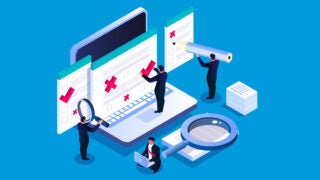Do androids dream of taking your job?
Nearly 40 percent of jobs in the United States may be vulnerable to automation, computerization, artificial intelligence, robots and other machines within 15 years, according to PricewaterhouseCoopers. USC experts in manufacturing, technology, labor, education and business discuss the continued growing pains for work and society in the age of automation.
Contact: Ian Chaffee at (213) 810-8554 or ichaffee@usc.edu
Automation means augmentation, not replacement

“As more sophisticated products are created that do not rely on cheap, human labor, automation will increase both profits and the wages of jobs where human workers are still needed.
“Automation assists humans in overcoming their inherent limitations in speed, strength, size, accuracy, consistency and reaction time. It also helps in realizing products that have complex shapes and small feature sizes, and which also require high accuracy. People would never be able to create these products on their own.
“Finally, automation can be leveraged to create innovative products that cannot be made using manual operations.”
Satyandra Gupta can discuss the ways automation will improve employment and marketplace conditions, as well as its continued importance to manufacturing. He is the Smith International Professor in Mechanical Engineering at the USC Viterbi School of Engineering and the director of the USC Center for Advanced Manufacturing (CAM).
Contact: (213) 740-0491 or guptask@usc.edu
Outpacing the job market’s safety net

“Automation is never going to stop.
“The Luddites had a similar thought a century ago when they tried to destroy the machines. Taxing them is a more refined approach, though it won’t necessarily be any more effective than the Luddites’ hammers were.
“Today, the problem is technology is changing very rapidly and companies are coming up with very innovative ways to replace people, and it’s happening quickly enough that we don’t have enough time for people in society to adjust in real time.
“The problem is that automation often takes away jobs that are very good matches for people’s unique skills, and then it’s very hard for that person then to have another job that pays as well.
“There are robots that are being deployed right now in parking lots that are taking the place of security guards, and security guard has been one of the last safe places for somebody who doesn’t have an advanced college degree … who, in the past, might have gotten a job on a manufacturing line that now doesn’t exist anymore either.” (Adapted from comments to BBC Radio)
Alec Levenson can discuss how automation is changing human resources, the impact of automation on labor and business costs, and Bill Gates’ proposed robot tax. He is a senior research scientist at the USC Marshall School of Business’ Center for Effective Organizations.
Contact: (310) 991-7215 or levenson@marshall.usc.edu
People and machines educating each other

“Artificial (i.e. machine) intelligence will play a more prominent role in learning environments shared by people and computers.
“The challenges include human-machine communication and the ability of computers to interact with people using natural (spoken and written) language, images, animation or perhaps video.
“Some learning systems may be more effective with intelligent computers working along with people to offer real-time support and predictive analytics.
“People and computers will literally need to educate each other, and the emerging collaborations and interactions will be unprecedented.”
Anthony Maddox can discuss STEM, the role of artificial intelligence in education, and accounting for automation in student and worker training. He is a professor of clinical education and engineering at the USC Rossier School of Education and the USC Viterbi School.
Contact: (213) 740-2864 or amaddox@rossier.usc.edu
Adapting to new logistics “on the job”

“Supply managers must have the foresight to recognize that employees who fear new technologies may be resistant to adopting or investing in them. Thus, communication about job stability as well as training programs can help C-suite personnel integrate new technologies into employees’ work functions and assist supply managers in overcoming that resistance.
“In addition, conversations throughout the organization about how new technologies will increase both employee and organization efficiency and productivity — and how that benefits employees — can assist in overcoming employee anxiety.
“By helping employees embrace a holistic view of the organization and its evolution, employees gain a vantage point from which they can review an organization’s entire logistics network.” (Comments excerpted from Inside Supply Management)
Nick Vyas can discuss how automation is affecting business supply chains and how organizations are implementing these new technologies. He is an assistant professor of clinical data sciences and operations at the USC Marshall School and the director of the USC Center for Global Supply Chain Management.
Contact: (213) 821-4079 or nikhilvy@marshall.usc.edu



